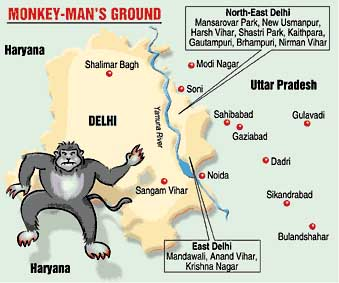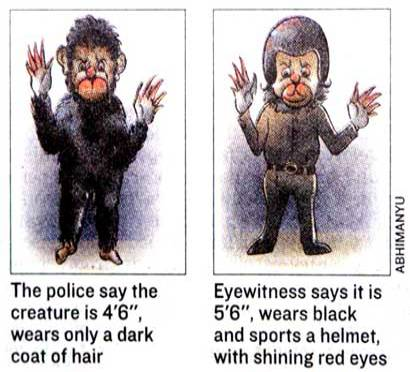|
Suresh Roy, Commissioner of Police, reported that he can't explain what it is that is traumatizing the populace, but he stated to Reuters that all indications point "towards an animal." Wow! What would it have been unless it was an animal? A '65 VW Beetle? If I were a resident on Delhi, the commissioner's obvious observation wouldn't reassure me; I would certainly hope that they were looking for an animal and not a VW. Didn't anything wear off on the Indians from all those years of British rule? Surely, they have read of the deductive reasoning of the great investigative sleuth, Sherlock Holmes. Commissioner Roy would be well advised to take some lessons from Mr. Holmes-perhaps he should start with one of my favorites: The Hounds of Baskerville. However, my sources indicate that it is not totally the fault of the police. There seems to be a great deal of discrepancy about what this monkey man looks like. The creature's description ranges from the size of a cat with a metallic hand to a creature standing over seven feet tall with "green lights for eyes and springs on its feet." Nevertheless, most eyewitnesses report that the monster is about four feet tall with "tawny eyes and large claws." At least, the police have something with which to work.
Another problem is that the Ghaziabad authorities are offering a reward of Rs 5,000 (or a little more than $100). Now, there is part of the problem. No smart Indian resident is going to go out of his or her way and even risk life or limb for a hundred bucks. The town fathers need to cough up a lot more money if they expect a reward will lead to the arrest and conviction of the ape-like attacker. The police chief of Ghaziabad, Prashant Kumar, states that he and his people are doing all that they can with the limited manpower that they possess. To supplement police patrols, frightened residents have formed vigilante groups to protect their women and children from this diminutive super monkey man that can spring twenty feet vertically in a single bound. No wonder that the creature has avoided capture. This monster must be stopped. Moreover, what if there is more than just one of these creatures? One can only imagine the chaos that this would cause as monkey men multiply and take over the cities, shrines, and sanctuaries throughout India. With the globalization of the world, can you envision what would happen if these creatures stowed away in the cargo area of a plane or boat and exported themselves to America and Europe? Even worse, what if the creature were to mate with some of our women? If you think that mad cow, and hoof and mouth diseases have caused near hysteria in Europe, wait until these monkey men take over Washington, London, and Paris. The chaos of infected cows will pale in comparison to the takeover of our world by these monkey men with green lights for eyes. Beyond warning my readers to be vigilant, I am seriously considering taking the summer off and going in search of the monkey man of India. If the authorities can't corral this cantankerous creature, I will ask Bill Shaw for the Telegraph's credit card and fly to Delhi in search of this elusive evolutionary anomaly. This could be big, really big. Imagine a 21st century version of Stanley and Livingston: "Monkey man, I presume." I wonder what Bill would pay for an exclusive story and pictures of me capturing the creature responsible for creating Hindu hysteria. This article appeared in the Dixon Telegraph on 6/7/01.
|







 Flash!
"Monkey Man Terrorizes Delhi." I
finally did it; I scooped Clark Kelly, the long-time reporter for the Telegraph
and an old friend, with a breaking news story.
Now for the story: for the past couple of weeks, a strange creature that
looks half man and monkey has reportedly attacked over two dozen residents of
the capital city of India, New Delhi, and Ghaziabad, a suburban area north of
the capital. The ape-like attacker
has also caused the deaths of several people.
One of its victims was a man that upon hearing that the predatory primate
was in his neighborhood jumped from his apartment roof to his death to avoid
being mauled by the menacing marauder.
Flash!
"Monkey Man Terrorizes Delhi." I
finally did it; I scooped Clark Kelly, the long-time reporter for the Telegraph
and an old friend, with a breaking news story.
Now for the story: for the past couple of weeks, a strange creature that
looks half man and monkey has reportedly attacked over two dozen residents of
the capital city of India, New Delhi, and Ghaziabad, a suburban area north of
the capital. The ape-like attacker
has also caused the deaths of several people.
One of its victims was a man that upon hearing that the predatory primate
was in his neighborhood jumped from his apartment roof to his death to avoid
being mauled by the menacing marauder. 